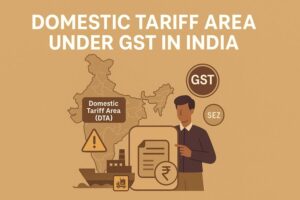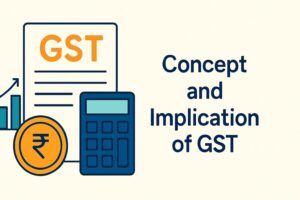What does business vertical in GST mean?
- 20 Aug 24
- 24 mins

What does business vertical in GST mean?
- What are Business Verticals in GST?
- Importance of Business Verticals in GST
- Implications of Business Verticals in GST
- Types of Business Verticals
- Challenges Faced by Businesses
- Additional Considerations for Businesses
- How do File GST Returns for Multiple GSTINs?
- Can I Use One GST Number for Multiple Businesses?
- Scenarios Where One GST Number Can Be Used
- Multiple GST Registrations in Different States
- Conclusion
Key Takeaways
- Business verticals in GST are distinct divisions within a single entity that provide different types of goods or services.
- GST impacts different verticals with specific tax rates, compliance requirements, and ITC rules.
- Compliance challenges include managing multiple GSTINs, accurate ITC allocation, and detailed record-keeping.
- Inter-vertical transactions require proper documentation and valuation to ensure correct tax treatment.
- Segmentation facilitates better tax management, compliance, and financial reporting for businesses under GST.
In the complex world of goods and services tax (GST) in India, one simpler term that frequently pops up is "business vertical." But what exactly does it mean, and why is it important for businesses? This article explains the concept of business verticals in GST, their implications, and how businesses can navigate the associated challenges.

What are Business Verticals in GST?
In the realm of Goods and Services Tax (GST) in India, a "business vertical" refers to distinct divisions or lines of business within a single legal entity that are engaged in providing different types of goods or services. Essentially, it allows businesses to segment their operations into separate business units based on the nature of the individual products or services they offer.
For example, a company that manufactures electronics and also runs a consulting service would have two business verticals—one for manufacturing and one for services. Under GST, these verticals can be registered separately, which helps in better management, compliance, and tracking of tax liabilities.
Importance of Business Verticals in GST
Understanding and registering business verticals separately under GST is crucial for several reasons:
- Efficient Tax Management: Different verticals might have varying tax rates and compliance requirements. Registering them separately helps businesses manage these differences more effectively.
- Accurate Financial Reporting: Segregating business activities into different verticals allows for more precise financial reporting and tracking of income and expenses specific to each vertical.
- Optimized Input Tax Credit (ITC): Properly managing ITC becomes easier with separate verticals, as businesses can ensure that the credits are accurately allocated to the relevant vertical.
- Compliance and Documentation: Each vertical can maintain its own set of records and documentation, simplifying the overall compliance process and reducing the risk of errors or omissions.
Implications of Business Verticals in GST
The implications of business verticals in the Goods and Services Tax (GST) system are essential for businesses to manage their operations efficiently. Here’s a detailed look at the key implications:
Taxation and Compliance
One of the most significant implications of having distinct business verticals is the impact on taxation and compliance. Each vertical may have different GST rates and specific compliance requirements. Businesses must ensure that each vertical adheres to its respective regulations, which can involve distinct tax filings, documentation, and record-keeping. This segregation helps in:
- Clear Tax Liability Calculation: Businesses can accurately calculate and pay the taxes due for each vertical.
- Simplified Audits: Separate records for each vertical make it easier to undergo audits and provide the necessary documentation.
- Regulatory Adherence: Ensuring each vertical meets its compliance requirements helps avoid legal issues and penalties.
Impact on Input Tax Credit (ITC)
Input Tax Credit is a mechanism that allows businesses to reduce their tax liability by claiming credit on taxes paid on inputs. When a business has multi-vertical operations, managing ITC becomes more complex but crucial. Here’s how ITC is impacted:
- Proper Allocation: Businesses must allocate ITC accurately to the respective verticals. This requires meticulous record-keeping to ensure that the credits claimed are legitimate and applicable to the right vertical.
- Documentation Requirements: Detailed invoices and records must be maintained for each vertical to support ITC claims, which can increase administrative workload but is necessary for compliance.
- Avoiding Misallocation: Misallocating ITC can lead to issues during audits and can attract penalties, so businesses must be diligent in their allocation processes.
Operational Efficiency
Managing multiple business verticals can lead to operational unit challenges but also offers opportunities for efficiency improvements.
- Streamlined Processes: Businesses can develop specialized processes and systems for each vertical, leading to more efficient operations within each segment.
- Focused Management: Having separate verticals allows for focused management and strategic planning tailored to the specific needs and goals of each vertical.
- Performance Tracking: Businesses can monitor the performance of each vertical independently, identifying areas for improvement and opportunities for growth.
Financial Reporting and Analysis
Segregating business verticals impacts financial reporting and analysis in several ways:
- Detailed Financial Statements: Businesses must prepare separate financial statements for each vertical, providing a clearer picture of each segment’s financial health.
- Accurate Profitability Analysis: Separate reporting allows businesses to analyze the profitability of each vertical independently, leading to better strategic decisions.
- Enhanced Transparency: Stakeholders, including investors and regulatory bodies, can gain a more transparent view of the business’s performance and compliance across different segments.
Strategic Business Decisions
Having distinct business verticals influences strategic business decisions in multiple aspects:
- Resource Allocation: Businesses can allocate resources more effectively based on the specific needs and potential of each vertical.
- Market Positioning: Companies can position each vertical differently in the market, tailoring marketing and sales strategies to suit the target audience of each segment.
- Risk Management: Segregating business activities into different verticals helps in identifying and managing risks unique to each segment, ensuring overall business stability.
Types of Business Verticals

In the context of Goods and Services Tax (GST) in India, businesses often need to register different lines of their operations as separate business verticals. This segregation helps in better compliance, management, and financial reporting. Here are the common types of business verticals:
Manufacturing
Manufacturing verticals involve the production of goods from raw materials. This category includes industries like automotive, electronics, textiles, and pharmaceuticals. The key characteristics of manufacturing verticals under GST include:
- Complex Supply Chains: Managing input tax credits for raw materials and components.
- Production Records: Maintaining detailed records of production processes and output.
- Tax Compliance: Ensuring compliance with GST rates applicable to manufactured goods.
Trading
Trading businesses are engaged in buying and selling goods. This vertical can include wholesalers, retailers, and distributors. Important aspects of trading verticals under GST are:
- Inventory Management: Tracking purchases and sales to ensure accurate GST reporting.
- Input Tax Credit: Claiming ITC on goods purchased for resale.
- Sales Documentation: Maintaining sales invoices and records to comply with GST filing requirements.
Service Providers
Service Providers offer intangible products such as consulting, IT services, financial services, and healthcare. Key features of service provider verticals under GST include:
- Service Invoices: issuing invoices for services rendered and ensuring they comply with GST regulations.
- Place of Supply Rules: Understanding the rules that determine the place of supply for service transactions.
- ITC on Input Services: Managing and claiming ITC on input services used to provide taxable services.
E-commerce
E-commerce businesses operate online platforms for selling goods or services. This vertical can include online marketplaces, retailers, and service providers. Critical aspects for e-commerce verticals under GST are:
- Tax Collection at Source (TCS): Understanding the TCS provisions applicable to e-commerce operators.
- Multiple Transactions: Managing GST Compliance for a High Volume of Small Transactions.
- Platform Compliance: Ensuring that the e-commerce platform complies with GST regulations, including registration and filing requirements.
Real Estate and Construction
Real Estate and Construction businesses involve activities like property development, construction services, and real estate transactions. Important elements of this vertical under GST include:
- Works Contracts: Understanding the GST implications on works contracts and composite supplies.
- Input Tax Credit on Capital Goods: Claiming ITC on machinery, equipment, and other capital goods used in construction.
- Project-based Accounting: Managing GST compliance and accounting on a project-by-project basis.
Logistics and Transportation
Logistics and Transportation businesses provide services related to the movement of goods and people. This vertical covers freight services, courier services, and passenger transport. Key considerations under GST are:
- Place of Supply: Determining the place of supply rules specific to transportation services.
- Documentation: Maintaining proper documentation for goods and services transported.
- ITC on Fuel and Vehicles: Claiming ITC on expenses related to fuel, maintenance, and vehicles.
Agriculture
Agriculture verticals include activities related to farming, dairy, and allied services. Specific aspects for agricultural businesses under GST are:
- Exemptions: Understanding the GST exemptions available for certain agricultural products and services.
- Input Tax Credit: Managing ITC on inputs used in agricultural production.
- Seasonal Business Cycles: Accounting for the seasonal nature of agricultural activities in GST compliance.
Challenges Faced by Businesses
The goods and services tax (GST) system can be complex for businesses, especially when dealing with multiple business verticals. Each vertical comes with its own set of challenges that need to be addressed for effective compliance and management. Here are some of the key challenges faced by businesses:
Complexity in Compliance
One of the foremost challenges is the complexity involved in complying with GST regulations for multiple business verticals. Each vertical may have different tax rates, exemptions, and compliance requirements, making it essential for businesses to:
- Stay Updated: Constantly monitor changes in GST laws and rules that apply to each vertical.
- Detailed Record-Keeping: Maintain separate records for each vertical to ensure accurate tax filings.
- Regular Training: Ensure that staff are regularly trained on GST compliance to avoid errors and penalties.
Managing Multiple GSTINs
Businesses operating multiple verticals often need to manage multiple GST Identification Numbers (GSTINs). Each GSTIN requires separate compliance activities, which include:
- Separate Filings: Filing GST returns for each GSTIN, which can be time-consuming and resource-intensive,.
- Consistent Record Maintenance: Keeping accurate and consistent records for each GSTIN to avoid discrepancies during audits.
- Coordinated Compliance: Ensuring that all GSTINs comply with the respective regulations and filing deadlines to prevent penalties.
Operational Hurdles
Managing multiple business verticals often leads to operational challenges, including:
- Coordination Between Verticals: Ensuring smooth coordination and communication between different verticals to avoid operational inefficiencies.
- Resource Allocation: Allocating resources effectively across different verticals to ensure optimal performance and compliance.
- Integration of Processes: Integrating processes and systems across verticals to streamline operations and reduce redundancy.
Accurate Input Tax Credit Allocation
Allocating Input Tax Credit (ITC) accurately across different business verticals can be challenging. Key issues include:
- Proper Documentation: Ensuring all necessary documents are in place to support ITC claims for each vertical.
- Avoiding Misallocation: Preventing the misallocation of ITC, which can lead to compliance issues and financial discrepancies.
- Complex Calculations: Managing complex ITC calculations for inter-vertical transactions and ensuring accurate reporting.
Inter-Vertical Transactions
Handling transactions between different business verticals requires careful management to avoid compliance issues.
- Transfer Pricing: Setting appropriate transfer pricing for transactions between verticals to ensure compliance with GST regulations.
- Documentation: Maintaining proper documentation for inter-vertical transactions to support tax filings and ITC claims.
- Reconciliation: Regularly reconciling transactions between verticals to ensure consistency and accuracy in financial records.
Financial Reporting and Analysis
Segregating business verticals impacts financial reporting and analysis, presenting challenges such as:
- Separate Financial Statements: Prepare separate financial statements for each vertical to provide a clear picture of their financial health.
- Consolidated Reporting: Combining financial data from all verticals for overall business analysis and reporting.
- Performance Metrics: Developing and tracking performance metrics for each vertical to identify areas for improvement.
Technology Integration
Leveraging technology to manage multiple business verticals effectively can be challenging.
- Choosing the Right Software: Selecting GST software that can handle the complexities of multiple verticals.
- Data Integration: Ensuring seamless integration of data across different verticals to provide a unified view of business operations.
- System Updates: Keeping technology systems updated with the latest GST regulations and requirements to ensure ongoing compliance.
Regulatory Changes
Frequent changes in GST regulations can pose significant challenges for businesses.
- Adapting to New Rules: Quickly adapting to new GST rules and regulations that impact different verticals.
- Updating Processes: Regularly updating business processes and systems to comply with regulatory changes.
- Training Staff: Continuously train staff to understand and implement new regulations effectively.
Additional Considerations for Businesses

When managing multiple business verticals under the Goods and Services Tax (GST) system, businesses must account for several additional factors to ensure seamless operations and compliance.
These considerations range from state-wise registrations to the impact on financial reporting and leveraging technology for efficiency. Here’s a detailed look at these key considerations:
State-wise GST Registration
For businesses operating in multiple states, state-wise GST registration is crucial. Each state in India has its own set of regulations and compliance requirements under GST. Here’s what businesses need to consider:
- Understanding Local Regulations: Each state may have different rules regarding tax rates, exemptions, and compliance procedures. Businesses must be well-versed with these local regulations to ensure compliance.
- Multiple GSTINs: Registering for GST in different states requires obtaining separate GST Identification Numbers (GSTINs) for each state. This increases the complexity of managing compliance and filing returns.
- State-specific Documentation: Businesses must maintain state-specific documentation for transactions conducted within and across state borders. This includes invoices, purchase orders, and records of interstate supplies.
- Compliance and Filing: Each GSTIN requires separate compliance activities, including GST file returns, payment of taxes, and maintaining records. Businesses must ensure timely compliance for each state to avoid penalties.
Impact on Financial Reporting
The segregation of business verticals has a significant impact on financial reporting and analysis. Here’s how businesses can manage this effectively:
- Separate Financial Statements: Each vertical should have its own financial statements to provide a clear picture of its financial health. This includes income statements, balance sheets, and cash flow statements.
- Consolidated Reporting: In addition to separate financial statements, businesses must also prepare consolidated reports that combine financial data from all verticals. This provides an overall view of the business’s performance and financial position.
- Accurate Allocation of Costs and Revenues: Properly allocating costs and revenues to the appropriate verticals is essential for accurate financial reporting. This helps in assessing the profitability and performance of each vertical independently.
- Audit Preparedness: Maintaining detailed and accurate records for each vertical simplifies the audit process. Businesses should be prepared for internal and external audits by ensuring all documentation is up-to-date and easily accessible.
Leveraging Technology for Efficiency
Technology plays a critical role in managing multiple business verticals under GST. Here’s how businesses can leverage technology to improve efficiency:
- GST Software Solutions: Utilizing GST-compliant software solutions can automate many aspects of tax management, including invoicing, tax calculations, efficient GST return filing, and record-keeping. This reduces the risk of errors and ensures timely compliance.
- Integration of Systems: Businesses should integrate their accounting, inventory management, and GST software to ensure seamless data flow and real-time updates. This integration helps in maintaining accurate records and simplifies compliance.
- Data Analytics: Leveraging data analytics tools can provide valuable insights into the performance of each vertical. Businesses can use these insights to make informed decisions, optimize operations, and improve profitability.
- Cloud-based Solutions: Adopting cloud-based solutions ensures that data is accessible from anywhere, providing flexibility and ease of management. This is particularly useful for businesses operating in multiple states or locations.
Regular Training and Updates
Keeping staff updated with the latest GST regulations and compliance requirements is essential for smooth operations. Here are some strategies:
- Continuous Training: Provide regular training sessions for employees involved in GST compliance and management. This helps keep them informed about the latest changes in GST laws and procedures.
- Updates and Bulletins: Subscribe to GST updates and bulletins from reliable sources to stay informed about regulatory changes. Disseminate this information to relevant staff promptly.
- Expert Consultation: Engage with GST experts or consultants to ensure compliance and get professional advice on complex GST issues. This can help in avoiding common pitfalls and navigating regulatory changes effectively.
How do File GST Returns for Multiple GSTINs?
Filing GST returns for multiple GST Identification Numbers (GSTINs) can be a complex process, but it's essential for businesses operating across different states or managing multiple business verticals. Here's a step-by-step guide to help streamline the process and ensure compliance:
Step-by-Step Process
Step 1: Gather Required Information
- Sales and Purchase Data: Collect detailed records of all sales and purchases for each GSTIN.
- Input Tax Credit (ITC) Details: Gather information on ITC claims for inputs and services.
- Invoices and Receipts: Ensure that all invoices and receipts are correctly recorded and categorized.
Step 2: Segregate Data by GSTIN
- Separate Records: Maintain distinct records for each GSTIN to avoid confusion and ensure accurate filings.
- Use Accounting Software: Utilize accounting software that supports multi-GSTIN management to automate data segregation.
Step 3: Login to GST Portal
- Access GST Portal: Visit the GST portal (www.gst.gov.in) and log in using the credentials for each GSTIN.
- Select the Appropriate GSTIN: Ensure you are filing returns for the correct GSTIN by selecting it from the dashboard.
Step 4: Prepare GSTR-1 (Outward Supplies)
- Enter Sales Details: Input details of all outward supplies (sales) for the respective GSTIN.
- Verify Data: Cross-check the entered data with your records to ensure accuracy.
Step 5: Prepare GSTR-2A (Auto-drafted Supplies)
- Check Auto-Drafted Supplies: Review the auto-drafted GSTR-2A for each GSTIN to verify details of inward supplies (purchases) from registered suppliers.
- Reconcile with Purchase Records: Reconcile the data with your purchase records and address any discrepancies.
Step 6: Prepare GSTR-3B (Monthly Summary Return)
- Summarize Tax Liabilities: Summarize the total tax liabilities, including details of sales, purchases, and ITC claimed.
- Calculate Net Tax Liability: Calculate the net tax liability after adjusting for ITC.
Step 7: File GSTR-9 (Annual Return)
- Compile Annual Data: Compile annual data for each GSTIN, including total sales, purchases, and ITC.
- Submit Annual Return: File GSTR-9 for each GSTIN, summarizing the financial year’s transactions.
Step 8: Submit the Returns
- Verify Information: Double-check all the information entered for accuracy.
- E-Sign and Submit: Use digital signature certificates (DSC) or e-sign to authenticate and submit the returns.
Step 9: Make Tax Payments
- Calculate Tax Due: Calculate the total tax due for each GSTIN.
- Make Payments: Use the GST portal to make the necessary tax payments.
Step 10: Maintain Records
- Keep Detailed Records: Maintain detailed records of all returns filed, tax payments made, and related documentation for each GSTIN.
- Audit Readiness: Ensure records are audit-ready by organizing them systematically.
Common Mistakes to Avoid
- Incorrect Data Entry: Double-check all entries to ensure accuracy. Incorrect data can lead to discrepancies and penalties.
- Missing Deadlines: Adhere to filing deadlines to avoid late fees and interest charges. Set reminders for due dates.
- Improper ITC Allocation: Ensure ITC is correctly allocated to the appropriate GSTIN to avoid compliance issues.
- Ignoring Reconciliation: Regularly reconcile purchase data with GSTR-2A to identify and resolve discrepancies.
- Incomplete Documentation: Maintain comprehensive documentation for each GSTIN to support ITC claims and filings.
Tips for Efficient Filing
- Use GST Software: Invest in reliable GST software that supports multi-GSTIN management to automate and streamline the filing process.
- Regular Updates: Stay updated with the latest GST regulations and changes to ensure compliance.
- Professional Assistance: Consider hiring a GST consultant or professional to manage filings, especially if handling multiple GSTINs.
- Consistent Record-Keeping: Maintain consistent and accurate records throughout the financial year to simplify the filing process.
Can I Use One GST Number for Multiple Businesses?

When managing multiple businesses, understanding the rules and regulations of the Goods and Services Tax (GST) system is crucial. One common question that arises is whether a single GST number can be used for multiple businesses.
Here's a detailed explanation, including relevant keywords to help you understand the implications and legal aspects.
Legal Implications of Using One GST Number for Multiple Businesses
Under the GST system in India, each business entity is required to obtain a unique GST Identification Number (GSTIN) for its operations. Here are the key legal implications:
- Distinct Legal Entities: Each business entity that operates as a separate entity must have its own GSTIN. Using one GST number for multiple legal entities can lead to compliance issues and penalties.
- Compliance Requirements: GST compliance involves regular filing of returns, maintaining detailed records, and ensuring accurate reporting. Different businesses may have distinct compliance requirements based on their nature and location, necessitating separate GSTINs.
- Tax Liability: Each GSTIN corresponds to a specific tax liability. Combining multiple businesses under one GST number can complicate the calculation and payment of taxes, leading to potential errors and legal complications.
Scenarios Where One GST Number Can Be Used
While separate GSTINs are generally required, there are specific scenarios where a single GST number may suffice:
- Same Legal Entity, Different Business Verticals: If multiple businesses operate as different verticals within the same legal entity, they can be registered under a single GST number. This is possible only if the entity chooses not to register each vertical separately.
- Single Location Operations: If multiple businesses operate from a single location under the same legal entity, they may use one GST number, provided the nature of their operations allows for it.
Benefits and Drawbacks of Using One GST Number
Using one GST number for multiple business verticals within the same legal entity has both benefits and drawbacks:
Benefits:
- Simplified Compliance: Managing a single GSTIN simplifies the compliance process, reducing the administrative burden of filing multiple returns.
- Cost-Effective: It can be more cost-effective to maintain one GSTIN, avoiding the costs associated with multiple registrations and compliance management.
Drawbacks:
- Complex Record-Keeping: Maintaining accurate records for different business verticals under one GST number can be complex and prone to errors.
- Risk of Misallocation: The risk of misallocating Input Tax Credit (ITC) and tax liabilities increases when multiple businesses are managed under a single GSTIN.
- Regulatory Scrutiny: A single GST number for multiple operations may attract more scrutiny from tax authorities, increasing the risk of audits and penalties.
Separate GSTINs for Different Businesses
For distinct legal entities or businesses operating in different states, separate GSTINs are mandatory. Here’s why:
- State-Specific Compliance: Each state in India has its own GST regulations. Separate GSTINs ensure that businesses comply with state-specific requirements.
- Clear Tax Liability: Separate GSTINs provide clarity in tax liability and help in accurate tax computation and payment.
- Avoiding Penalties: Failure to register separate GSTINs for different businesses can lead to severe penalties, including fines and interest on unpaid taxes.
Steps to Obtain Multiple GSTINs
If your businesses require separate GSTINs, here’s a step-by-step process to obtain them:
- Determine the Need: Assess whether each business or business vertical requires a separate GSTIN based on legal entity status and operational needs.
- Prepare Documentation: Gather necessary documents, including PAN, proof of business registration, address proof, and bank account details.
- Submit Applications: Apply for GSTINs through the GST portal (www.gst.gov.in) by submitting separate applications for each business.
- Verification and Approval: The GST authorities will verify the applications and issue GSTINs upon approval.
- Compliance and Record-Keeping: Ensure each GSTIN is used for its respective business, maintaining separate records and compliance requirements.
Multiple GST Registrations in Different States
For businesses operating across multiple states in India, understanding the process and implications of obtaining multiple GST registrations is crucial. Each state requires a separate GST Identification Number (GSTIN) to ensure compliance with the Goods and Services Tax (GST) regulations. Here's a comprehensive guide to help you navigate this process:
Requirements for Multiple GST Registration
- Business Operations in Multiple States: If your business has a presence or operations in more than one state, you are required to obtain a separate GSTIN for each state.
- Distinct Locations: Separate GST registrations are mandatory for each distinct location of business within different states, even if they are part of the same legal entity.
- Compliance with State-Specific Regulations: Each state in India has its own set of GST regulations and compliance requirements, necessitating separate registrations.
Procedure for Obtaining Multiple GSTINs
Step 1: Gather the necessary documents.
- PAN of the Business: A permanent Number (PAN) is mandatory for GST registration.
- Proof of Business Registration: Certificates of incorporation or partnership deeds.
- Address Proof: Lease agreement, utility bills, or property tax receipts for the business location.
- Bank Account Details: Bank statement or a canceled check.
- Digital Signature Certificate (DSC): Required for the online application process.
Step 2: Access the GST Portal
- Visit the GST portal (www.gst.gov.in).
- Log in using your credentials or register if you are a new user.
Step 3: Fill Out the Application Form
- Select the Appropriate State: Choose the state for which you are applying for a GSTIN.
- Fill in Business Details: Provide all the required information about your business operations in that state.
- Upload Documents: Attach the necessary documents, including address proof and business registration certificates.
- Verify with DSC: Use a Digital Signature Certificate to verify and submit the application.
Step 4: Verification and Approval
- Application Review: The GST authorities will review the application and may request additional information or documents.
- Approval and GSTIN Issuance: Upon successful verification, a unique GSTIN for the specific state will be issued.
Step 5: Repeat for Other States
- Repeat the application process for each state where your business has operations, ensuring compliance with local regulations.
Compliance Requirements for Multiple GSTINs
- Separate Record-Keeping: Maintain distinct records for each GSTIN, including invoices, purchase orders, and financial statements, to ensure clarity and compliance.
- Regular Filing of Returns: File GST returns separately for each GSTIN. This includes GSTR-1 (outward supplies), GSTR-3B (monthly summary), and annual returns (GSTR-9).
- Payment of Taxes: Calculate and pay taxes separately for each GSTIN based on the transactions and operations within that state.
- Reconciliation: Regularly reconcile the data for each GSTIN to ensure accuracy in filings and avoid discrepancies during audits.
- Stay Updated: Keep abreast of state-specific GST regulations and updates to ensure ongoing compliance.
Challenges and Tips for Managing Multiple GSTINs
- Increased Administrative Burden: Managing multiple GSTINs increases the complexity of compliance, record-keeping, and return filing.
- Risk of Errors: The likelihood of errors in tax calculation, ITC allocation, and return filing rises with multiple GSTINs.
- Resource Allocation: Ensuring adequate resources and trained personnel for managing compliance in each state can be challenging.
Conclusion
Managing business verticals in GST is crucial for businesses to ensure compliance and optimize their tax liabilities. By segregating business activities, maintaining accurate records, and leveraging technology, businesses can navigate the complexities of GST effectively.
💡Facing delays in GST payment? Get started with PICE today and streamline your GST payments. Click here to sign up and take the first step towards hassle-free GST management.
 By
By 
















